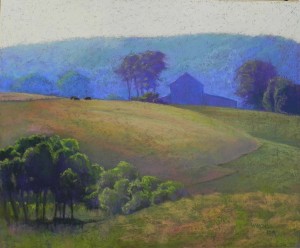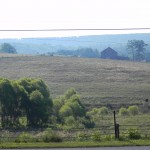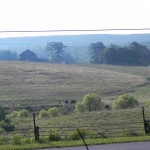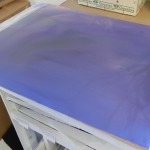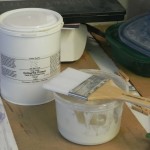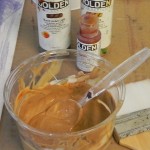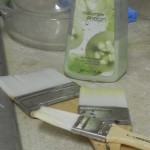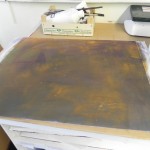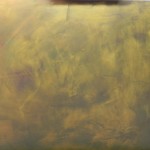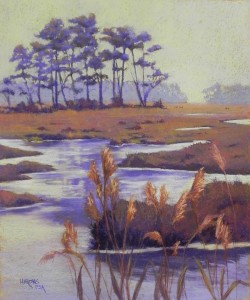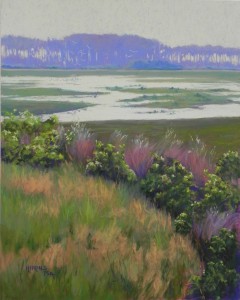Last Friday I drove to Loretto, PA to visit my friend Karl, who is in the Federal Correctional Institution. I am his mentor–or at least I was. He’s mainly doing oil now and painting rock stars and I don’t think I have a lot to contribute! Anyway, it was a beautiful day and I brought my camera, stopping on the way up and back to take pictures. In the morning, I filmed this wonderful barn that I’ve seen on every trip. The sunlight was coming from behind and creating a magical glow. I’ve always loved the way the hillside forms a line that leads to the barn. However, I made changes to the composition. I printed out three photos–two of the barn and a reference shot of cows. I’m including the two primary shots so you can see how I rearranged elements of the landscape. I tried the barn on the left first, but decided that it should be on the right to offset the trees on the lower left. This painting is done on the surface that I created in my last post. It was quite hard and rough and there were many bristles still stuck in the gel, despite my efforts to eradicate them. But I decided to use it anyway, thinking that I was just playing. Of course, now, I really like the picture! (They actually fit with the brush lines and aren’t too distracting.) My biggest challenge was the large hillside in front of the barn. I had it too light originally and ended up brushing off some color to darken it. It has a glow now, but isn’t too starkly different from the other grasses and barn. Because of the hardness and roughness of the surface, I ended up using a lot of soft pastels on this painting. I started with Holbeins laying in broad shapes. But they made almost no impact. So I moved to Girault and finally to softer Unisons, etc. I thought about adding other details, larger cows in the lower right and a tractor to the left of the barn. But I decided against all of that. I like my three small cows in the background. I’m off for New England on Saturday so I expect this to be my last painting and post for some time. I’ll be painting outside in Tiverton and Little Compton next Mon.-Wed. and looking forward to seeing old friends and new, as well as my mother and sisters. Enjoy the end of the summer!
Monthly Archives: August 2015
Making Your Own Surface and Saving a Surface When the Painting Fails
I recently promised to explain my process of preparing my own surfaces. I often use the same process when a painting fails and I want to save the surface. I had a 20 x 24 painting that I really disliked on a mounted sheet of UART. The mounting alone cost $18! So I didn’t want to throw this out. Working in my home studio, I took the painting outside (it’s a gorgeous day!) and using an old bristle brush, I removed as much of the pastel as I could. Then I took a sponge and a bowl of water, and washed off as much as possible. By doing this, the violets and blues mixed together and covered the paper, eliminating the original underpainting, which I definitely didn’t want showing through! I could have tried to get rid of more pastel if I wanted to keep the sanded surface of the UART. But I find that the pastel fills in too much of the tooth and it’s better to apply a new surface. Instead, I prepared some Colourfix Liquid Primer to brush on. I use a separate plastic container (saved from the grocery store) to spoon out enough primer that will be toned. The primer is clear–this is critical! The already toned primers cannot be further colored. To this, I add liquid acrylic, usually raw sienna, burnt umber, and some quinacrydone gold. Using a plastic spoon, I mix the primer well until I have a good blend and shade. (Note, if it’s too light it won’t look like much.) I use Loew-Cornell acrylic brushes to brush on the primer. I wash out the brushes thoroughly using my hand soap so that none of the primer stays in the brush (which will ruin it for future use). (Note: I’ve been using these brushes for many years. They come in packages of 3: 1″, 2″ and 3″ which I use according to the size of the paper or board. I have always liked them because they didn’t leave large ridges in the surface. However, lately, their quality has gone down and they continually leave bristles on the surface that have to be removed. This is a pain and can destroy the surface as well. Not sure what to do about this! If you click on the final surface you’ll see some of the problem areas that resulted from removing bristles.)
I apply one layer, brushing in different directions, trying to get the surface as smooth as possible. Then I dry it well with a hair dryer. Test with fingers very lightly! If too sticky dry some more or wait. Then apply a second coat and dry again. The resulting surface will be very different from the original, but can be used to create wonderful paintings! This is a great way of reusing Pastelbord particularly, since it’s so hard and can take the liquid primer applications. When preparing a surface such as Rives that might buckle, I make sure it is completely dry, put a clean sheet of paper or glassine over it, then weight it down with magazines. This helps it lay as flat as possible.
To be clear, I create my own surfaces using various substrates, such as BFK Rives printmaking paper, heavy smooth mat board, museum board or gatorfoam (I used this in the past). I also use this method for reused surfaces that are either very sturdy (e.g., Pastelbord) or have been premounted (UART, Wallis, etc.)
Here is a list of supplies that you need:
A pastel gel. I use Colourfix Liquid Primer clear, bought in a tub from Dakota Pastels. You can also use Golden acrylic gel for pastels. Or make your own (there are many recipes but I don’t do this).
A plastic disposable container or other such container. One with a lid is handy to retain unused gel. Save containers from the grocery store!
Plastic spoons (I buy a bag of 100)
Brushes of various sizes. I use Loew-Cornell acrylic white brushes. Try to get something that won’t shed.
Soap to clean the brushes. Note: I have a sink in my home studio. Be careful to clean the sink. The primer will harden and make a mess of your kitchen sink!!!
A clean new substrate or brushed off painting: printmaking paper, mat board, museum or illustration board, etc. Note: the texture of the substrate will determine the final look of your painting. You might want to try several different substrates to see what you like best.
To those in the Rockville area, I will be including this in the upcoming Exploring Pastel class at Washington Art Works, beginning at the end of Sept. AND: all of this is included in Appendix D of Finding Your Style in Pastel! I hope this has been useful. Feel free to ask questions or let me know what needs clarification.
Two Paintings From Chincoteague
I spent today in the studio completing my third painting from our May trip to Chincoteague. Last week I completed a 20 x 24; today’s is a 20 x 16. They were done on different surfaces using different approaches to color and technique. The first, Misty Day, was done on Rives using a gold-toned Colourfix liquid primer base. I used direct application of pastel onto the toned and textured surface. I like the soft edges that are produced and it fits this subject matter very nicely. For this painting, I used 3 black and white photos, finally settling on one to use as the primary image. I added three small ponies in the back right from one of the other photos. I chose not to use greens, instead, making this more of a fall scene.
The painting I did today was done on UART using an underpainting and the color photo. The colors pretty much match those in the photo, but I pushed the foreground grasses a bit. I added egrets in the far distance and a hint of birds in the water–it needed them and there were many birds everywhere–just not in my photo! For the underpainting, I used violets, pinks, oranges, and reds from a new Holbein set. I like using these pastels for underpaintings–the colors are really gorgeous. The bushes were done with Blue Earth greens and the foreground grasses are all Girault.

